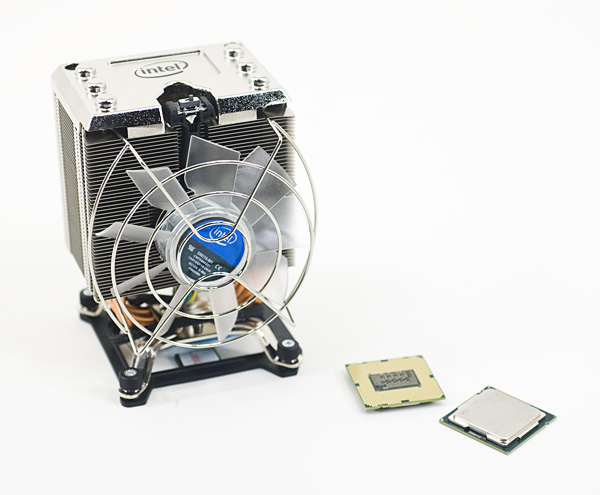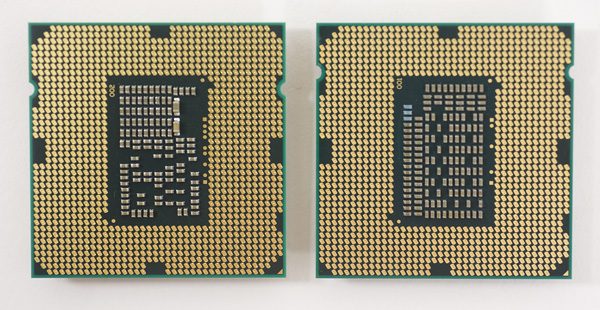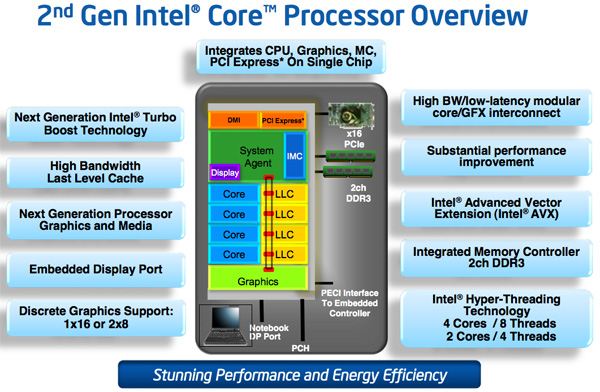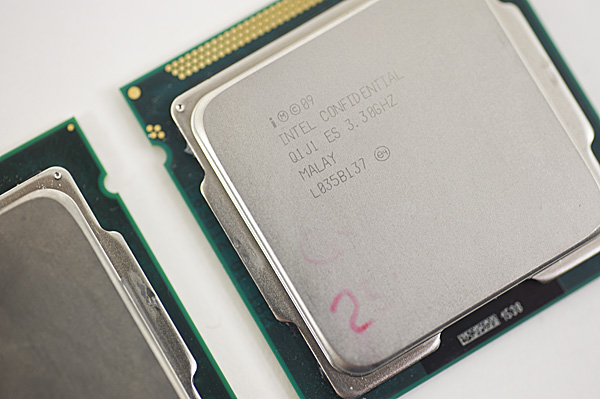The Sandy Bridge Review: Intel Core i7-2600K, i5-2500K and Core i3-2100 Tested
by Anand Lal Shimpi on January 3, 2011 12:01 AM ESTIntel never quite reached 4GHz with the Pentium 4. Despite being on a dedicated quest for gigahertz the company stopped short and the best we ever got was 3.8GHz. Within a year the clock (no pun intended) was reset and we were all running Core 2 Duos at under 3GHz. With each subsequent generation Intel inched those clock speeds higher, but preferred to gain performance through efficiency rather than frequency.
Today, Intel quietly finishes what it started nearly a decade ago. When running a single threaded application, the Core i7-2600K will power gate three of its four cores and turbo the fourth core as high as 3.8GHz. Even with two cores active, the 32nm chip can run them both up to 3.7GHz. The only thing keeping us from 4GHz is a lack of competition to be honest. Relying on single-click motherboard auto-overclocking alone, the 2600K is easily at 4.4GHz. For those of you who want more, 4.6-4.8GHz is within reason. All on air, without any exotic cooling.
Unlike Lynnfield, Sandy Bridge isn’t just about turbo (although Sandy Bridge’s turbo modes are quite awesome). Architecturally it’s the biggest change we’ve seen since Conroe, although looking at a high level block diagram you wouldn’t be able to tell. Architecture width hasn’t changed, but internally SNB features a complete redesign of the Out of Order execution engine, a more efficient front end (courtesy of the decoded µop cache) and a very high bandwidth ring bus. The L3 cache is also lower and the memory controller is much faster. I’ve gone through the architectural improvements in detail here. The end result is better performance all around. For the same money as you would’ve spent last year, you can expect anywhere from 10-50% more performance in existing applications and games from Sandy Bridge.
I mentioned Lynnfield because the performance mainstream quad-core segment hasn’t seen an update from Intel since its introduction in 2009. Sandy Bridge is here to fix that. The architecture will be available, at least initially, in both dual and quad-core flavors for mobile and desktop (our full look at mobile Sandy Bridge is here). By the end of the year we’ll have a six core version as well for the high-end desktop market, not to mention countless Xeon branded SKUs for servers.
The quad-core desktop Sandy Bridge die clocks in at 995 million transistors. We’ll have to wait for Ivy Bridge to break a billion in the mainstream. Encompassed within that transistor count are 114 million transistors dedicated to what Intel now calls Processor Graphics. Internally it’s referred to as the Gen 6.0 Processor Graphics Controller or GT for short. This is a DX10 graphics core that shares little in common with its predecessor. Like the SNB CPU architecture, the GT core architecture has been revamped and optimized to increase IPC. As we mentioned in our Sandy Bridge Preview article, Intel’s new integrated graphics is enough to make $40-$50 discrete GPUs redundant. For the first time since the i740, Intel is taking 3D graphics performance seriously.
| CPU Specification Comparison | ||||||||
| CPU | Manufacturing Process | Cores | Transistor Count | Die Size | ||||
| AMD Thuban 6C | 45nm | 6 | 904M | 346mm2 | ||||
| AMD Deneb 4C | 45nm | 4 | 758M | 258mm2 | ||||
| Intel Gulftown 6C | 32nm | 6 | 1.17B | 240mm2 | ||||
| Intel Nehalem/Bloomfield 4C | 45nm | 4 | 731M | 263mm2 | ||||
| Intel Sandy Bridge 4C | 32nm | 4 | 995M | 216mm2 | ||||
| Intel Lynnfield 4C | 45nm | 4 | 774M | 296mm2 | ||||
| Intel Clarkdale 2C | 32nm | 2 | 384M | 81mm2 | ||||
| Intel Sandy Bridge 2C (GT1) | 32nm | 2 | 504M | 131mm2 | ||||
| Intel Sandy Bridge 2C (GT2) | 32nm | 2 | 624M | 149mm2 | ||||
It’s not all about hardware either. Game testing and driver validation actually has real money behind it at Intel. We’ll see how this progresses over time, but graphics at Intel today very different than it has ever been.
Despite the heavy spending on an on-die GPU, the focus of Sandy Bridge is still improving CPU performance: each core requires 55 million transistors. A complete quad-core Sandy Bridge die measures 216mm2, only 2mm2 larger than the old Core 2 Quad 9000 series (but much, much faster).
As a concession to advancements in GPU computing rather than build SNB’s GPU into a general purpose compute monster Intel outfitted the chip with a small amount of fixed function hardware to enable hardware video transcoding. The marketing folks at Intel call this Quick Sync technology. And for the first time I’ll say that the marketing name doesn’t do the technology justice: Quick Sync puts all previous attempts at GPU accelerated video transcoding to shame. It’s that fast.
There’s also the overclocking controversy. Sandy Bridge is all about integration and thus the clock generator has been moved off of the motherboard and on to the chipset, where its frequency is almost completely locked. BCLK overclocking is dead. Thankfully for some of the chips we care about, Intel will offer fully unlocked versions for the enthusiast community. And these are likely the ones you’ll want to buy. Here’s a preview of what’s to come:
The lower end chips are fully locked. We had difficulty recommending most of the Clarkdale lineup and I wouldn’t be surprised if we have that same problem going forward at the very low-end of the SNB family. AMD will be free to compete for marketshare down there just as it is today.
With the CPU comes a new platform as well. In order to maintain its healthy profit margins Intel breaks backwards compatibility (and thus avoids validation) with existing LGA-1156 motherboards, Sandy Bridge requires a new LGA-1155 motherboard equipped with a 6-series chipset. You can re-use your old heatsinks however.

Clarkdale (left) vs. Sandy Bridge (right)
The new chipset brings 6Gbps SATA support (2 ports) but still no native USB 3.0. That’ll be a 2012 thing it seems.













283 Comments
View All Comments
Taft12 - Tuesday, January 4, 2011 - link
You first.ReaM - Tuesday, January 4, 2011 - link
the six core 980x still owns them in all tests where all cores are used.I dont know 22k in cinebench is really not a reason to buy the new i7, I reach 24k on air with i7 860 and my i5 runs on 20k on air.
Short term performance is real good, but I dont care if I wait for a package to unpack for 7 seconds or 8, for long term like rendering, neither there is a reason to upgrade.
I recommend you get the older 1156 off ebay and save a ton of money.
I have the i5 on hackintosh, I am wondering if 1155 will be hackintoshable
Spivonious - Tuesday, January 4, 2011 - link
I have to disagree with Anand; I feel the QuickSync image is the best of the four in all cases. Yes, there is some edge-softening going on, so you lose some of the finer detail that ATi and SNB gives you, but when viewing on a small screen such as one on an iPhone/iPod, I'd rather have the smoothed-out shapes than pixel-perfect detail.wutsurstyle - Tuesday, January 4, 2011 - link
I started my computing days with Intel but I'm so put off by the way Intel is marketing their new toys. Get this but you can't have that...buy that, but your purchase must include other things. And even after I throw my wallet to Intel, I still would not have a OC'd Sandy Bridge with useful IGP and Quicksync. But wait, throw more money on a Z68 a little later. Oh...and there's a shiny new LGA2011 in the works. Anyone worried that they started naming sockets after the year it comes out? Yay for spending!AMD..please save us!
MrCrispy - Tuesday, January 4, 2011 - link
Why the bloody hell don't the K parts support VT-d ?! I can only imagine it will be introduced at a price premium in a later part.slick121 - Tuesday, January 4, 2011 - link
Wow I just realized this. I really hate this type of market segmentation.Navier - Tuesday, January 4, 2011 - link
I'm a little confused why Quick Sync needs to have a monitor connected to the MB to work. I'm trying to understand why having a monitor connected is so important for video transcoding, vs. playback etc.Is this a software limitation? Either in the UEFI (BIOS) or drivers? Or something more systemic in the hardware.
What happens on a P67 motherboard? Does the P67 board disable the on die GPU? Effectively disabling Quick Sync support? This seems a very unfortunate over-site for such a promising feature. Will a future driver/firmware update resolve this limitation?
Thanks
NUSNA_moebius - Tuesday, January 4, 2011 - link
Intel HD 3000 - ~115 Million transistorsAMD Radeon HD 3450 - 181 Million transistors - 8 SIMDs
AMD Radeon HD 4550 - 242 Million transistors - 16 SIMDs
AMD Radeon HD 5450 - 292 Million transistors - 16 SIMDs
AMD Xenos (Xbox 360 GPU) - 232 Million transistors + 105 Million (eDRAM daughter die) = 337 Million transistors - 48 SIMDs
Xenos I think in the end is still a good two, two and a half times more powerful than the Radeon 5450. Xenos does not have to be OpenCL, Direct Compute, DX11 nor fully DX10 compliant (a 50 million jump from the 4550 going from DX10.1 to 11), nor contains hardware video decode, integrated HDMI output with 5.1 audio controller (even the old Radeon 3200 clocks in at 150 million + transistors). What I would like some clarification on is if the transistor count for the Xenos includes Northbridge functions..............
Clearly PC GPUs have insane transistor counts in order to be highly compatible. It is commendable how well the Intel HD 3000 does with only 115 Million, but it's important to note that older products like the X1900 had 384 Million transistors, back when DX9.0c was the aim and in pure throughput, it should match or closely trail Xenos at 500 MHz. Going from the 3450 to 4550 GPUs, we go up another 60 million for 8 more SIMDs of a similar DX10.1 compatible nature, as well as the probable increases for hardware video decode, etc. So basically, to come into similar order as the Xenos in terms of SIMD counts (of which Xenos is 48 of it's own type I must emphasize), we would need 60 million transistors per 8 SIMDs, which would put us at about 360 million transistors for a 48 SIMD (240 SP) AMD part that is DX 10.1 compatible and not equipped with anything unrelated to graphics processing.
Yes, it's a most basic comparison (and probably fundamentally wrong in some regards), but I think it sheds some light on the idea that the Radeon HD 5450 really still pales in comparison to the Xenos. We have much better GPUs like Redwood that are twice as powerful with their higher clock speeds + 400 SPs (627 Million transistors total) and consume less energy than Xenos ever did. Of course, this isn't taking memory bandwidth or framebuffer size into account, nor the added benefits of console optimization.
frankanderson - Tuesday, January 4, 2011 - link
I'm still rocking my Q6600 + Gigabyte X38 DS5 board, upgraded to a GTX580 and been waiting for Sandy, definitely looking forward to this once the dust settles..Thanks Anand...
Spivonious - Wednesday, January 5, 2011 - link
I'm still on E6600 + P965 board. Honestly, I would upgrade my video card (HD3850) before doing a complete system upgrade, even with Sandy Bridge being so much faster than my old Conroe. I have yet to run a game that wasn't playable at full detail. Maybe my standards are just lower than others.